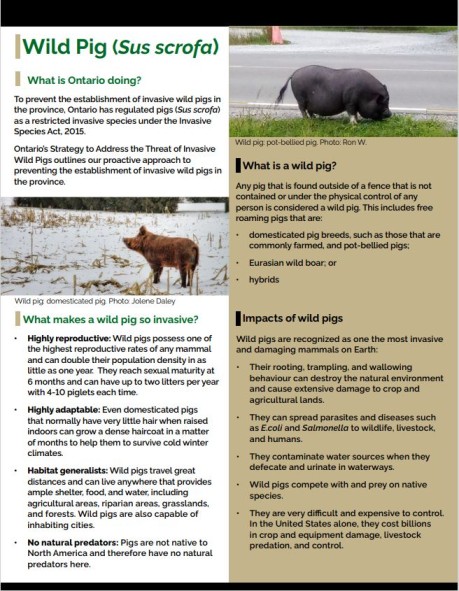Wild Pigs (Sus scrofa)
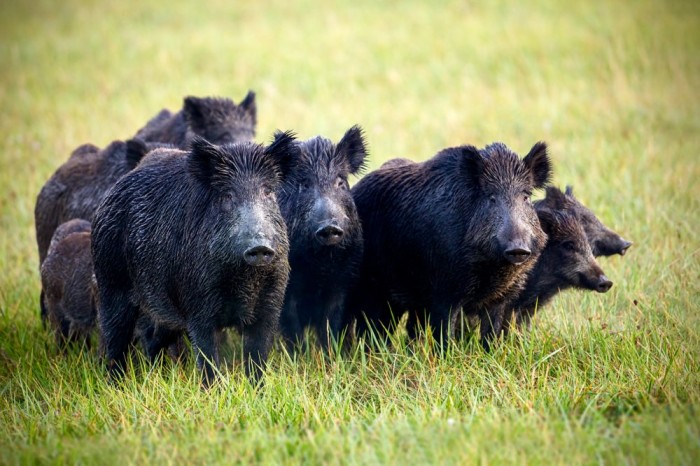
Photo: agcanada.com
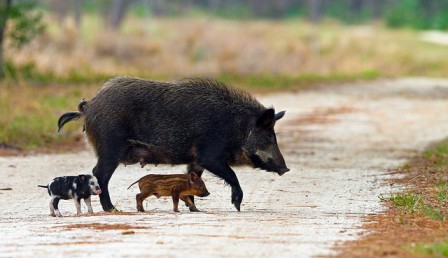
Photo: atriptoireland.com
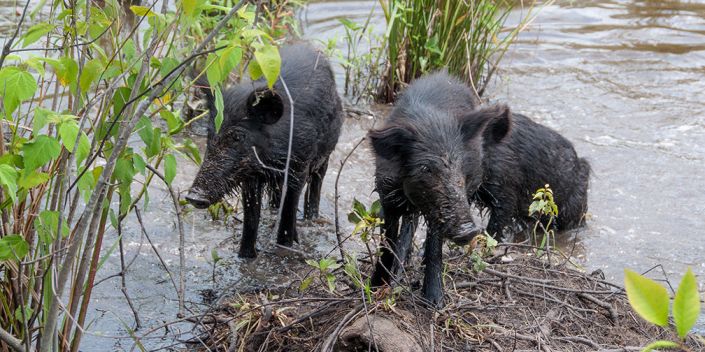
Photo: Ontario Nature
Other common names: feral hog, feral swine, feral pig, wild boar, piney woods rooter, wild hog, Eurasian wild boar
French common name: Cochon sauvage
Order: Artiodactyla
Family: Suidae
Did you know? The territory of a male wild pig can be 300 square kilometres and sows can encompass 230 square kilometres.
Introduction
Wild pigs (Sus scrofa) are one of the most invasive terrestrial mammals worldwide. They are native to Eurasia and parts of North Africa. Spread of wild pigs has been primarily through human introduction; they are also expanding through natural dispersal.
Wild pigs have a broad geographic range and can easily adapt and survive in new environments due to their high fecundity (large number of offspring produced), early sexual maturity, varied diet, long lifespans, and highly adaptive nature. They are one of the most damaging invasive species in the United States and are becoming an alarming concern for Canadian provinces, especially in the Prairies.
General Information
Wild pigs can be described as any pig that is “outside of a fence” including domestic pigs, Eurasian wild boar, and hybrids of domestic pigs and Eurasian wild boar. They range in size from 3.5-5 ft in length and can weigh from 30 to 420 lbs as adults (Ontario).
Female wild pigs are known to be smaller than males, with their size becoming more apparent as the animal ages.
Wild pigs have a wide range of colours from black to brownish-red to white. They can also be speckled or have a solid colour. Other distinguishing features include long snouts, large tusks, wedge-shaped heads, and coarse hair (Ontario).
Wild pigs can breed any time of the year with females producing two litters of 1-7 piglets every 12-15 months.
Females mature as early as six months, which can lead to wild pig populations doubling every four months. This means wild pigs have a high reproductive potential, which can lead to rapid spread and increased impacts on the environment.
Generally, wild pigs live for four or five years but can live up to eight years. Wilds pigs are primarily nocturnal (Missouri Department of Conservation).
Wild pigs can be found in a variety of habitats including forests, agricultural areas, grassy savanna areas, shrublands and marshy swamplands (AnimalDiversity.org).
Some wild pig populations are located in remote, rugged terrain where water is abundant including seeps, ponds, and streams. When found in these areas, the populations are small and isolated (Missouri Department of Conservation).
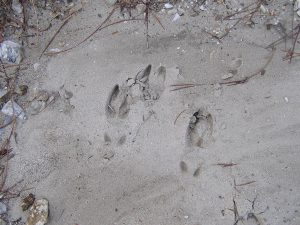 Wild pig tracks display similar but distinguishing features between the front and hind tracks. Both tracks are approximately 2 ½ inches long with two hooves. In the front track, their dewclaws sometimes show a small crescent beside and behind the hoof prints whereas in the hind track it sometimes shows dots.
Wild pig tracks display similar but distinguishing features between the front and hind tracks. Both tracks are approximately 2 ½ inches long with two hooves. In the front track, their dewclaws sometimes show a small crescent beside and behind the hoof prints whereas in the hind track it sometimes shows dots.
Other distinguishing signs include (Missouri Department of Conservation):
- Toe tips are blunt which can help differentiate from other two-hoofed tracks.
- Hooves are shorter in length and more parallel when compared to deer.
- Hind tracks are often ahead of the front tracks.
- Wild pigs can have a stride of 18 inches.
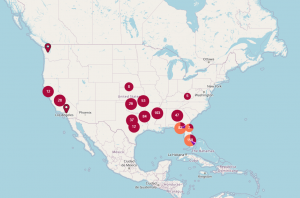 (Photo: EDDMaps)
(Photo: EDDMaps)
Wild pigs were first introduced to Canada from Europe beginning in the 1980’s as exotic livestock for meat. Due to human introductions, wild pigs have been expanding globally with populations present on all continents except Antarctica. In Canada, wild pigs have spread throughout the country since the late 1980’s.
To date, established populations can be found in Saskatchewan, Alberta, and Manitoba, with scattered populations in British Columbia, Ontario and Quebec (University of Saskatchewan).
Wild pigs have numerous negative effects on ecosystems within their non-native range (AnimalDiversity.org):
- In preparation to give birth, females use saplings and other woody plants that they either break off or uproot completely to build nests. This, along with other rooting behaviour, prevents new tree seedling establishment, reduces seed survival and success, and reduces plant species richness.
- Displace soil and small undergrowth, leading to erosion, soil deterioration, degradation of natural areas and impact to water quality.
- Transmit parasites (i.e., lice, American dog ticks) to humans and other animals.
- Loss of native flora and fauna.
- Compete with native wildlife for food, water, and space.
- Use their tusks and snouts to root into the ground to dig for roots, tubers, bulbs, worms, insects, slugs, and snails.
- Damage to crops and pasturelands.
Wild pigs can also have economic and social impacts (AnimalDiversity.org; Ontario):
- Increased costs for farmers due to damaged crops, losing or having to treat infected livestock, and needing to build barriers to keep wild pigs out.
- Aggressive behaviour towards humans or pets.
- High costs to control wild pigs if they become established in Ontario.
What You Can Do?
If you see a wild pig or have information about a sighting, please report it to:
- iNaturalist Ontario Wild Pig Reporting web page (www.inaturalist.org/projects/ontario-wild-pig-reporting) – download the app on a mobile device or register an account using a desktop computer, or
- Ministry of Northern Development, Mines, Natural Resources and Forestry’s email account for reporting wild pigs: wildpigs@ontario.ca
If you believe you have seen a wild pig or signs of wild pigs:
- Note the date, and time of the sighting.
- Note the location (intersecting roads, landmarks or GPS coordinates).
- Take pictures or a video, if possible.
- Note the number of pigs and whether piglets are present.
- If possible, identify whether it is an isolated sighting or if the same pig has been seen multiple times.
Reporting
Ontario
Sightings of invasive pigs in Ontario can be reported to the ministry.
Phone: 1-833-933-2355
Email: wildpigs@ontario.ca
See here for more information on reporting in Ontario.
Quebec
Sightings of invasive pigs in Quebec can be reported to the ministry.
Phone: 1-800-463-2191
Email:centralesos@mffp.gouv.qc.ca
See here for more information on reporting in Quebec.
Alberta
Sightings of invasive pigs in Alberta can be reported to the Alberta Invasive Species Council’s “Squeal on Pigs” Program.
Phone: 310-FARM
See here for more information on reporting in Alberta.
Saskatchewan
Sightings of invasive pigs in Saskatchewan can be reported to Sask Pork.
Phone: 833-744-7768
See here for more information on reporting in Saskatchewan.
Other Provinces
See our reporting page for more resources.
Fact Sheet
Articles and Research
The Invasive Species Centre aims to connect stakeholders. The following are links to resources that have been created by external organizations.
Interpreting and predicting the spread of invasive wild pigs.
Resources
Missouri Department of Conservation. (n.d.). Feral Hogs in Missouri.
Missouri Department of Conservation. (n.d.). Feral Hog.
Nature Conservancy Canada. (n.d.). Wild hog.
Ontario Invading Species Awareness Program. (2021). Wild Pigs.
Peters, D. (2020, September 19). The Clock Is Ticking on America’s ‘Feral Swine Bomb’.

